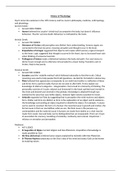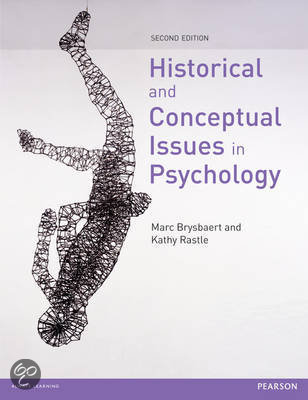History of Psychology
Psych came into existence in the 19th Century and has roots in philosophy, medicine, anthropology
and physiology.
Ancient Greek:
Around 3000-700BCE
Homer believed the 'psuche' (mind/soul) accompanies the body, but doesn’t influence
behaviour. 'Psuche' survives death. Behaviour is motivated by the Gods.
Archaic Greek:
Around 700-500BCE
Alcmaeon of Croton said perception was distinct from understanding. Sensory organs are
connected to the brain by poroi, meaning sensation and thought occur in the brain.
Empedocles of Acragas suggested that objects emit copies which sensory organs transport
to the heart. Logic suggested that thought occurred in the heart, due to increased heart rate
when thinking of someone loved etc.
Pythagoras of Samos made a distinction between the body and spirit. Our soul moves to
divine if pure enough and is otherwise reincarnated to a lesser being. Founded a sect in
Croton, Italy to live purely.
Classical Greek:
Around 500-323BCE
Socrates used the 'midwife method' which followed rationality to find the truth. Critical
reasoning was used to help people find truth/goodness. He died for his beliefs in democracy.
Plato believed that appearance corresponds to our world and reality is a reflection of ideas
and forms from a perfect reality that we do not exist in after birth. Forms explain our
knowledge of abstract categories - categorisation. Forms lead to a hierarchy of thinking. The
personality consists of 3 souls: rational soul (immortal) in the head, spirited soul (mortal) in
the chest and desired soul (mortal) in the genitals. Knowledge is attained through rays
emitted by the eyes that scan/strike objects, however light remains essential for vision.
Aristotle expanded on Plato by suggesting that in perception the mind receives and objects
form. Matter and form are distinct as form is the explanation of an object and its existence -
the knowledge surrounding an object required to identify the object. For example, 4 causes
can be used to construct the form of a human: the essential cause is growth and motion, the
formal cause is that our soul defines what we are, the final cause is the purpose e.g.
contemplation and the material cause is humans are made from bodies as a chair may be
made from wood. Soul and body can be distinguished but are inseparable. There are 3 laws
of association for memory consisting of similarity, continuity and contrast. Empiricism =
reliance on sensation and perception.
Medieval:
467-1350CE
St Augustine of Hippo married religion and Neo-Platonism. Acquisition of knowledge is
made possible by God.
Ibn Sina (Avicenna) combined sense organs explained by Aristotle with Neo-Platonism.
St Thomas Aquinas elaborates on Ibn Sina's idea of the mind and states God can be known
by studying nature.
, Chapter 1 of CHIPs
Invention of writing:
Preliterate civilisations were shown to have 3 characteristics by Lindberg (1992):
Skills are not based on understanding and instead on knowledge of what to do and when.
Knowledge is not easily transferred and is therefore limited to few generations, practical
skills are prioritised when passing on knowledge.
Myths exist in the form of gods in which animism occurs, projecting human characteristics on
inanimate objects. Lindberg viewed the myths as providing moral/social guidance within the
community and solutions to illness. However, inconsistencies were ignored without being
written down leading to the conclusion that scientific development only occurs with written
records.
Written language was first seen in China (6,000 BCE), Egypt (3,200 BCE), Sumer (3,200 BCE) and
America (300 BCE). The first writing systems used a combination of pictograms and phonograms e.g.
Egyptian hieroglyphs. This led to the development of the Phoenician alphabet forming the Arabic,
Hebrew and Greek writing system. Chinese has remains to resemble pictograms and phonograms,
however it developed into a logographic system.
The development of writing systems allowed the passage of knowledge between individuals, groups
and cultures; this prevented this from needing to be rediscovered. However, Socrates believed
written documents encouraged laziness of memory and therefore kept no written records of his work
and ideas.
As written records became more popular, more people were encouraged to learn to read as it
became a valuable skill. However, students/readers were discouraged from questioning books and
texts, this is known as the scholastic method.
Discovery of numbers:
Powell and Frankenstein (1997) found the earliest evidence of counting in Africa dating back to
35,000-20,000 BCE. Humans could easily distinguish up to 3 using markings. Babies are able to make
this distinction as well as tribes who have a number naming system of one, two and many. Larger
numbers require a more complex system which explains the development of tallies. Grouping into
the base number 5 occurs because it is the first number to surpass the distinguishable number of
markings and it is the number of fingers on a hand.
Indo-European languages share the origins of the names of their numbers, suggesting the numbers
one to ten were already named before the languages began to develop separately. Incorporating
base 10 into the naming system to allow naming of other numbers was found to be difficult and
explain why 11 is 'eleven' and 12 is 'twelve'.
The numbers 1-24 has been given symbols by the Greeks in 600 BCE due to the 24 letters in their
alphabet. This was altered to fit the base 10 system to allow easier symbols to be used, however it
was not systematic since 38 was XXXVIII and 50 was L. Instead, a nine symbol system was developed
in India to represent the numbers 1-9. This was accompanied by a place coding system to represent
all numbers, but the absence of a symbol for 0 meant 22 could represent 22, 202, 220, 2002 ect.
Fertile crescent:





